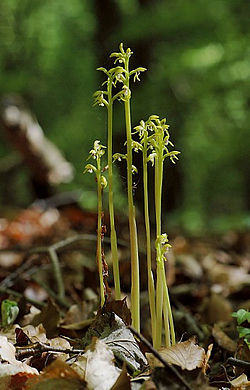| Name | Year | Rank | Notes |
|---|
| Corallorhiza anandaeMalhotra & Balodi | 1984 | species | = het. |
| Corallorhiza corallorhiza(L.) H.Karst. | 1886 | species | ≡ hom., not validly publ. |
| Corallorhiza corallorhiza subsp. coloradensisCockerell | 1916 | subspecies | = het., not validly publ. |
| Corallorhiza dentataHost | 1831 | species | = het. |
| Corallorhiza ericetorumDrejer | 1843 | species | = het. |
| Corallorhiza halleriRich. | 1817 | species | = het. |
| Corallorhiza innataR.Br. | 1813 | species | ≡ hom. |
| Corallorhiza innata var. discolorRchb. | 1830 | variety | = het. |
| Corallorhiza innata subsp. ericetorum(Drejer) Nyman | 1882 | subspecies | = het. |
| Corallorhiza innata var. ericetorum(Drejer) Rchb.f. | 1851 | variety | = het. |
| Corallorhiza innata var. virescens(Drejer) Farr | 1904 | variety | = het. |
| Corallorhiza intactaCham. & Schltdl. | 1828 | species | = het., orth. var. |
| Corallorhiza integraChâtel. | 1760 | species | = het. |
| Corallorhiza jacquemontiiDecne. | 1844 | species | = het. |
| Corallorhiza nemoralisSw. ex Nyman | 1882 | species | = het., not validly publ. |
| Corallorhiza neottiaScop. | 1771 | species | = het. |
| Corallorhiza occidentalisBach.Pyl. | 1826 | species | = het. |
| Corallorhiza trifida var. ericetorum(Drejer) Rchb.f. | 1851 | variety | = het. |
| Corallorhiza trifida f. ericetorum(Drejer) Soó | 1928 | form | = het. |
| Corallorhiza trifida var. integra(Châtel.) Schinz & Thell. | 1914 | variety | = het. |
| Corallorhiza trifida f. integra(Châtel.) Soó | 1928 | form | = het. |
| Corallorhiza trifida f. suaveolensBordz. | 1950 | form | = het. |
| Corallorhiza trifida var. verna(Nutt.) Fernald | 1946 | variety | = het. |
| Corallorhiza trifida f. verna(Nutt.) P.M.Br. | 2006 | form | = het. |
| Corallorhiza trifida subsp. virescens(Drejer) Løjtnant | 1996 | subspecies | = het. |
| Corallorhiza trifida var. virescens(Drejer) Farw. | 1941 | variety | = het. |
| Corallorhiza vernaNutt. | 1823 | species | = het. |
| Corallorhiza virescensDrejer | 1843 | species | = het. |
| Corallorhiza wyomingensisHellm. & K.Hellm. | 1931 | species | = het. |
| Cymbidium corallorhiza(L.) Sw. | 1800 | species | ≡ hom. |
| Epidendrum corallorhizon(L.) Poir. | 1810 | species | ≡ hom. |
| Epipactis corallorhiza(L.) Crantz | 1769 | species | ≡ hom. |
| Helleborine corallorhiza(L.) F.W.Schmidt | 1793 | species | ≡ hom. |
| Neottia corallorhiza(L.) Kuntze | 1891 | species | ≡ hom. |
| Ophrys corallorhizaL. | 1753 | species | ≡ hom. |
| Notes: ≡ homotypic synonym; = heterotypic synonym |
|---|




